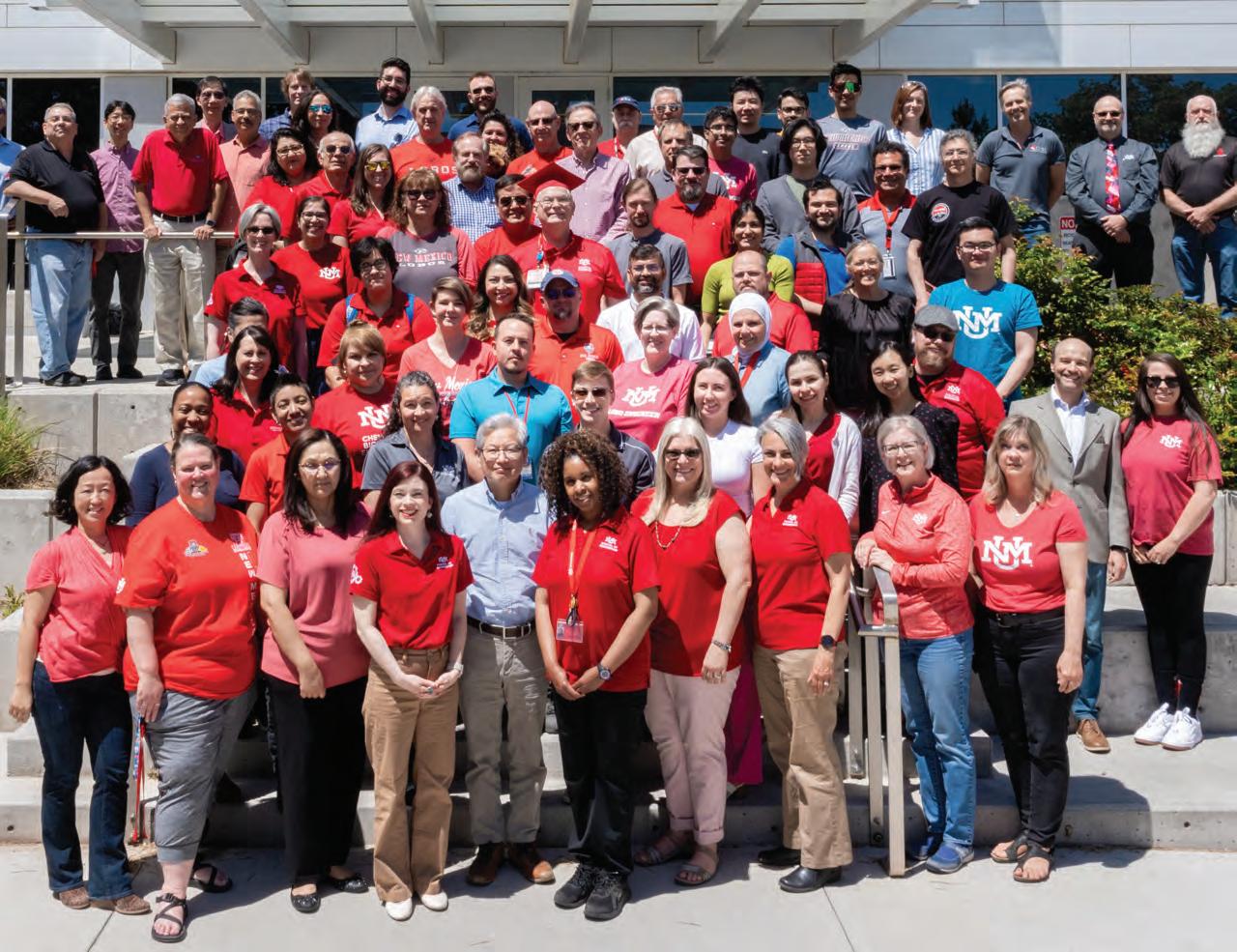
Taking the Long View



Taking the Long View

WELCOME TO THE 2024 edition of UNM Engineering!
It’s hard to believe that this spring, I completed my first full year at UNM, and as I expected, it’s been a very busy year with a lot to report!
Maracea Chase to our Development team and said goodbye to Kim Delker, the editor of this magazine and marketing manager since 2014 who left in August for a senior-level marketing position in the UNM Office of Academic Affairs. We’re all saddened by departures of our team members, but are excited by our future possibilities.
We developed a roadmap for student, faculty and staff success, with a special emphasis on making sure our students are well-prepared and supported.

First off, we have completed our School strategic plan and now are in the process of beginning implementation throughout the departments and centers. After a lot of hard work and discussion, we developed a roadmap for student, faculty and staff success, with a special emphasis on making sure our students are wellprepared and supported. You can read the full plan at engineering.unm.edu.
There have also been a lot of comings and goings the last year, including prominent retirements of Abhaya Datye (see Page 2) and Charles Fleddermann (see Page 6), although both will continue to serve the School as parttime working retirees. We also welcomed Susan Bogus Halter as the chair of the Gerald May Department of Civil, Construction and Environmental Engineering (see Page 14), as well as new associate deans Steven Graves and Shuang Luan (see Page 15). On the staff front, we welcomed Mary Wolford, Olivia Gannon and
As always, I’m proud to report that our research success is robust as ever, with two faculty winning National Science Foundation CAREER Awards (see Page 8), as well as UNM leading one of six NSF TRAILBLAZER Awards and an NSF project to establish a Center for Equity in Engineering that I am leading! (See Pages 12–13).
Last but certainly not least is the amazing news that we have exceeded our $50 million goal in the Our Time campaign for the School! This is a major undertaking that will be celebrated Nov. 7 at the Distinguished Alumni Awards Ceremony, so mark your calendars and stay tuned for more information.
I hope you enjoy catching up with some of what we’ve been up to the last year, and thanks to all of you for your support of the School of Engineering!

Donna Riley
Jim and Ellen King Dean of Engineering and Computing
end of an era: Senior associate dean for academics Charles Fleddermann retires after nearly 40 years

UNM Engineering
UNM

Mexico
School of Engineering, Centennial Engineering Center, Room 3071, MSC01 1140, 1 University of New Mexico, Albuquerque, NM 87131-1140. 505-277-5521 engineering.unm.edu
Managing Editor
Writing
Delker
Design Brian Hurshman, Sparkplug Studio
Photography
Swanson, Obscura Inc.
Rodriguez Duran


Abhaya Datye led the effort to secure funding for a high-resolution scanning transmission electron microscope, housed in UNM’s Physics, Astronomy and Interdisciplinary Science (PAIS) Building.

AFTER 40 YEARS OF INNOVATING AT UNM AND BEYOND, ABHAYA DATYE HAS ‘NO PLANS TO STOP’
The year was 1984, and Abhaya Datye — a young chemical engineer graduating with his Ph.D. from the University of Michigan — had a decision to make.
Specializing in the field of catalysis (which is the study of materials that speed up the rate of a chemical reaction), he found himself in an indemand field in the 1980s. In one major application, automobile manufacturers were starting to install catalytic converters in vehicles due to stricter federal environmental regulations, so that technology was rapidly evolving.
“Because of this new device called a catalytic converter, catalysis dominated the scene, especially in Michigan,” Datye said.
Companies like General Motors (located in nearby Detroit) were recruiting highly skilled chemical engineers like Datye to improve and expand the technology, offering high salaries and other perks.
However, despite the lure of large research budgets and the cache that comes with working for a leading automaker, Datye chose a different career route, that of academia. And in particular, in the far-away high desert state of New Mexico.
Although pursuing a faculty job at The University of New Mexico may have seemed unfamiliar, Datye said that UNM felt like a home early on, thanks to connections he made in graduate school. Frank Williams, a chemical engineer who had left General Motors to be department chair in chemical engineering at UNM, convinced Datye to give New Mexico a try.
Also working in UNM’s favor was Sandia National Laboratories, with their surface science and electron microscopy (EM) programs, as well as many connections that Datye had there.
He said despite many opportunities to leave New Mexico, the reasons that brought him here also kept him here. In 2007, he earned the rank of UNM Distinguished Professor, and in 2010, he became a Regents’ Professor.
Now after 40 years as a faculty member at UNM, Datye is retiring, although his work schedule and travel ledger might not reflect it, as he continues to work, attend conferences, meet with his former students and win awards for his work. Because he is still involved in so much, he shudders at the word “retire.”
“I have no plans to stop.”
Datye is the son of a civil engineer, although he chose chemical engineering to focus on in college in India, not even really knowing what it was. He just knew that he “didn’t want electrical engineering” and that despite his father trying to convince him to become a civil engineer, “I wanted to be different.”
He earned a bachelor’s degree in chemical engineering from the Indian Institute of Technology in Bombay in 1975, then worked briefly in industry in India as a research assistant for Hindustan Lever Limited (where his first project was converting wax into soap) and a scientific officer at Hindustan Organic Chemicals (where he was in research and development in petrochemicals).
It was those brief experiences that first sparked interest in a lifelong passion for catalysis, which soon led him to the U.S. for graduate school and further study. He earned a master’s degree in chemical engineering from the University of Cincinnati, then to the University of Michigan for his Ph.D.
“There were a lot of unknowns about catalysis at the time,” he said. “I realized that people didn’t
understand catalysts. Industry struggled with catalyst deactivation, loss of performance during use, and they didn’t fully understand the reasons.”
As Datye explains, to understand catalysts, you must look at the atomic level. That is where electron microscopy comes into play.
“You need EM to see objects at the nanoscale, or even beyond,” Datye said. “For instance, in my research with catalysts, you need to be able to see at the atomic level, so that you can design the next generation of catalysts for automotive emissions control and for meeting our needs for energy and chemicals.”
The fact that UNM acquired scanning transmission electron microscope capabilities in the mid-1980s was a big factor in attracting Datye to UNM, as he could perform research that allowed him to see objects that are invisible to the human eye and in fact 100,000 times smaller than a human hair. Seeing matter at this tiny level — the atomic level — has broad applications for research.
While the original electron microscope at UNM was top of the line when Back to the Future was in theaters, rapid advances in technology demanded that EM keep up. However, that technology comes with a heavy price tag, and for a state institution, major pieces of equipment mean that faculty must find funding through writing successful proposals. So Datye went to work and has been involved in every acquisition of electron microscopes since he arrived at UNM.
After many tries and many disappointments, in 2018, Datye and a multidisciplinary team had a big success.
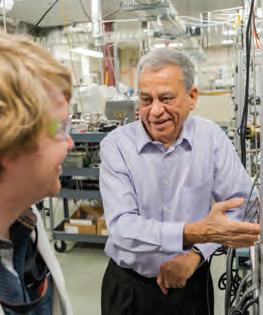


He was the principal investigator of a grant from the National Science Foundation to purchase a highresolution scanning transmission electron microscope, which was the first in the state with its particular capabilities. The aberration-corrected scanning transmission electron microscope has capabilities far beyond what was offered on campus, or anywhere in the state. “With this electron microscope, we wanted to be state of the art at UNM,” he said.
Datye’s expertise in electron microscopy was certainly key to obtaining the funding, but he said it was his extensive experience in collaboration, proposal writing and understanding how large projects are funded that led to success. Although delayed a bit due to the pandemic, the microscope was installed in a custom-designed electron microscopy and X-ray diffraction suite within UNM’s Physics, Astronomy and Interdisciplinary Science (PAIS) building, in 2021. The space in the building, which was completed shortly before the pandemic, is controlled for vibration, cooling, and electromagnetic field requirements, and is centrally located to encourage interdisciplinary work. A long-standing partnership with Distinguished Professor Adrian Brearley in Earth and Planetary Sciences has made it possible for this team to provide advanced electron microscopy tools to UNM researchers
“Having electron microscopy as a tool gave me access to industry and also focus on fundamental research,” he said. “Here was something that aided in the understanding of catalysis.”
Datye said the acquisition of this microscope has been major boost to electron microscopy research group at UNM which extends beyond him and the Department of Chemical and Biological Engineering.
“My interest was always in electron microscopy,” he said. “I’m most proud now of how I was able to get so many students interested in EM.”
Aside from his large research imprint at UNM and globally, Datye’s impact has been felt in the academic sphere at UNM. He is a former chair of the Department of Chemical and Biological Engineering, and his passion for integrating research into education inspired him to lead the creation of new fields of study for the School of Engineering, including an interdisciplinary graduate program in nanoscience and microsystems engineering. He ran one of the longest running National Science Foundation REU (Research Experiences for Undergraduates) sites, providing summer research internships to over 300 undergraduates over a 24-year period.
In addition, he took over the Center for Microengineered Materials (CMEM) when the late Doug Smith, a longtime friend and colleague, went on to found NanoPore and several spinoff companies in 1994. CMEM continues to be a major player in the research
profile of not only the School of Engineering but UNM as a whole, resulting in a variety of collaborations. Datye’s list of achievements, citations, accomplishments and awards is impressive, massive and continues to grow. Some of the highlights include being a fellow of the American Institute of Chemical Engineers, the Microscopy Society of America, and the Royal Society of Chemistry. His research has led to multiple international collaborations and sabbaticals in the UK, France and Denmark, He has been actively involved in the North American Catalysis Society, where he serves as a board member and has helped organize two national meetings held in the Rocky Mountain region. In addition, he is serving on the Department of Energy Basic Energy Sciences advisory committee. This summer, he received the 2024 award for Exceptional Achievements in Catalysis from the American Chemical Society.
Datye’s group has pioneered the development of electron microscopy tools for the study of catalysts. His current work involves fundamental studies of catalyst sintering, especially the stabilization of isolated single atoms on supports for high temperature catalytic applications such as exhaust catalysis and alkane dehydrogenation.
“Our lab was involved in so many things,” he said.
In 2017, that impact grew further when UNM became part of a National Science Foundation-funded Engineering Research Center that is working to develop new technologies to produce fuels from U.S. shale gas deposits. UNM researchers are partnering with lead institution Purdue University in the Center for Innovative and Strategic Transformation of Alkane Resources, or CISTAR.
In addition to research in the lab and working with industry, Datye is also passionate about what goes on in the classroom. In 2016, he became a principal investigator on “FACETS: Formation of Accomplished Chemical Engineers for Transforming Society, a 5-year project funded by the National Science Foundation, which addresses the urgent need to produce more engineers who are ready to solve societal problems.
Datye is married to Ranjana, whom he met in India when they were both college students. They have three grown daughters located around the country and five grandchildren.
Although he will have plenty to keep him busy in academia, he is looking forward to spending more time with family, as well as further developing hobbies such as cooking (“Cooking is chemistry”) and gardening with native plants.
Currently, his group includes three Ph.D. students, two master’s students, two research scientists and several undergraduates. Recently, he has been involved in reaching out to as many of his former students as possible to keep in touch and get a glimpse of the impact his approximately 70 graduate students he has mentored have made in the last four decades.
He is currently involved in a project with Sandia National Laboratories involving solar energy, looking at ways to trap the sun’s energy to provide heat for chemical reactions. Future projects include investigating ways to reduce the carbon impact of aviation through turning natural gas and biomass into sustainable aviation fuels or even developing novel materials, using electron microscopy to look at improving efficiency of catalysts at the atomic level, and to develop bio-based fuels.
While Datye says he currently has several years of funding on current projects, the sky is the limit in terms of potential future projects that can address worldaltering needs
“Being inspired by real-world problems and having a connection to industry is what makes me passionate,” he said. “There’s a lot more to do.”
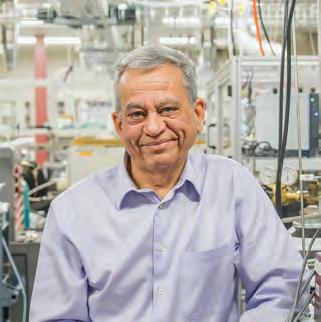

Senior associate dean for academics Charles Fleddermann retires after nearly 40 years
CHARLES B. FLEDDERMANN, WHO JOINED THE UNIVERSITY OF NEW MEXICO SCHOOL OF ENGINEERING IN FALL 1985, RETIRED THIS SUMMER AFTER NEARLY 40 YEARS, MOST RECENTLY AS AN ASSOCIATE DEAN.
Since 2002, he has been associate dean for academic affairs and community engagement in the School of Engineering, where he oversees the School’s academic advising and the Engineering Student Success Center. He also is involved in curriculum approval, statewide articulation and accreditation — including ABET, the agency that accredits programs in engineering and other related disciplines.
In 2023, he was interim Jim and Ellen King Dean of Engineering and Computing before Donna Riley began, and later that year, he was promoted to senior associate dean.
He earned a bachelor’s degree in electrical engineering from the University of Notre Dame in 1977, worked at Texas Instruments for a year, then entered graduate school to earn a master’s and Ph.D. in electrical engineering from the University of Illinois at Urbana-Champaign in 1980 and 1985, respectively.
Fleddermann became known in the academic world at UNM for teaching engineering ethics courses, as well as microelectronics and circuit theory. He was promoted to associate professor in 1991 and full professor in 1998.
After achieving tenure, Fleddermann began directing his career path more in the realm of student services, academic affairs, administration and outreach. He was selected as associate chair for undergraduate affairs in the Department of Electrical and Computer Engineering in 2001 and also served as acting dean of Graduate Studies at UNM from 2007–09. In addition to
serving as interim dean of the School of Engineering from January to March 31, 2023, he was the interim chair of the Department of Nuclear Engineering in 2019-20 as well as this academic year.
Along with teaching, administration and service, another prominent part of Fleddermann’s resume involves his association with ABET, a nonprofit, non-governmental agency that accredits programs in applied and natural science, computing, engineering and engineering technology. ABET accredits more than 4,500 college and university programs. For a couple of decades, he was the resident expert on ABET in the School of Engineering, leading the School through several successful evaluation cycles, and has traveled the globe on about a dozen trips as an ABET evaluator.
“I HOPE THAT I HAVE HAD AN IMPACT ON THE STUDENTS, AS WELL AS IMPROVING THE CURRICULUM OF OUR PROGRAMS,”
During his career, he interacted with many students, faculty, alumni, UNM leaders and even leaders at other institutions and organizations, like the New Mexico Higher Education Department involving curriculum and program changes and expansions.
Fleddermann said that what attracted him in the first place to the field of engineering is where he feels he has had the greatest impact.
“I hope that I have had an impact on the students, as well as improving the curriculum of our programs,” he said. “What we do with engineering and design curriculum, you get a warm, fuzzy feeling when you realize you created a program that helped students learn. We are helping students solve problems and helping faculty be better educators.”
Two School of Engineering assistant professors were honored with the National Science Foundation (NSF) CAREER Award during the 2023–24 academic year. The CAREER Award is NSF’s most prestigious award in support of junior faculty who exemplify the role of scholar-teacher, through outstanding research, excellent education, and the integration of research and education.
Amanda Bienz, from the Department of Computer Science, received the NSF CAREER Award for a project that seeks to ensure that the performance of parallel computer applications matches the performance of the hardware. “Towards Exascale Performance of Parallel Applications” is a five-year, $557,000 project that is funded Feb. 1, 2024, through Jan. 31, 2029.
The project, which will fund one graduate student and one undergraduate student, addresses the reality that each generation of supercomputers is more powerful than the previous version, with computing speeds for massive numbers of operations that can be completed in the blink of an eye.
Such supercomputers are used for processing complex data needed for computer simulations for everything ranging from weather modeling to cancer treatment. But as powerful as the hardware on these high-performance computers is, for them to work to maximum capacity, the applications need to match that speed and performance, which has long been a problem. Bienz is tackling that with this project.
Bienz said the inspiration for this project came naturally since this gap in performance between hardware and applications is a common frustration. Although the performance level of hardware will continue to improve as technology develops, Bienz said the goal with this project is to reduce the performance gap between the applications and the hardware. “The main idea is to change the performance level of the applications so that when hardware advances in the future, the applications can keep up,” she said. “Data is now moving to GPUs [graphics processing units] instead of CPUs [central processing units]. We need to understand why we get the performance we get, and why the applications do not match the expected performance.”

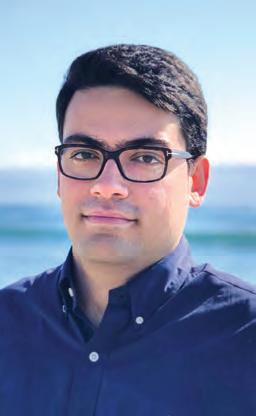
Also receiving a CAREER Award is Ali Bidram from the Department of Electrical and Computer Engineering. He leading a project called “Stochastic Optimization and Physics-informed Machine Learning for Scalable and Intelligent Adaptive Protection of Power Systems.” The five-year, $517,000 project began April 1, 2024, and continues through March 21, 2029.
Bidram said the work will focus on improving the resilience of power grids by designing a data-driven, adaptive protection platform that will take into account the needs for power systems in today’s high-demand environments. The resilience and reliability of power grids have become a growing issue in recent years in a world that increasingly relies upon electrical power for everything from computers, phones and even charging electric vehicles.
“The project will bring transformative change by designing intelligent and adaptive protection schemes in response to challenges associated with modern power grids in the presence of extreme events,” he said. “There is a need to redesign the conventional protection systems to make them adaptive to the prevailing power grid conditions. The goal is to make the protection systems more resilient by utilizing stochastic optimization algorithms and physics-informed machine learning techniques.”
Through both hardware and software solutions, Bidram will design a protection platform that will be able to handle adaptive protection actions in transmission as well as distribution on electric power grids.
their feet wet

Quyen Le, a chemical engineering student, presents “Addressing Water Scarcity Using Membrane Distillation Technique to Purify Existing Wastewater Resources” at the Water Science Communication Fellowship event in April.

WHAT DO DOUGHNUT ECONOMICS, A MIDDLE SCHOOL LESSON PLAN AND TINY COW GRAPHICS ALL HAVE IN COMMON?
All of these things were represented in various projects as part of the 2024 UNM Undergraduate Water Science Communication Fellowship presentations this spring at UNM.
The program pairs undergraduate students with faculty and other students across campus to work together to create a creative communication project around water science that would be used to explain the research to general audience. The event, which had its genesis under the UNM Grand Challenges focus area of sustainable water resources, was one of the events in the annual Undergraduate Research Opportunity Conference (UROC).
Students majoring in everything from chemical engineering to political science took part in the presentations, where they communicated their research projects related to the issues of water resources and the environment, as told from each student’s unique viewpoint — influenced by their academic major, the work of a UNM mentor, and their personal interests and talents.
For some, the project was a podcast, a painting or a sculpture (one of which featured running water). For others, the project involved a video or a website. And other students took a more traditional approach, communicating their research on a poster.
The Water Science Communication Fellowship was started in 2022 by Anjali Mulchandani, assistant professor in the Gerald May Department of Civil, Construction and Environmental Engineering, along with Sydney Donohue Jobe, education specialist for the Center for Water and the Environment.
Since then, the event has grown from 10 students the first year to 15 in 2024. It has also grown in its reach, with students who participated in a previous year now serving as mentors for the current cohort of undergraduates.
Jobe said the goal of the water science communication fellowships is to provide an accessible way for undergraduates to get involved in research, especially with those outside of their academic field.
“I’m most proud of how it has continued on for now the third year,” she said. “It is incredibly nice to see how we’re taking a student cohort and having those students continue on with their mentor and the research. We’re also seeing them get internships and




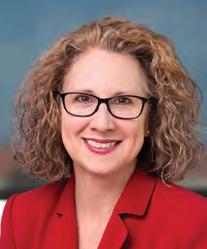

Shuang (Sean) Luan has been selected as the associate dean for academic affairs and community engagement. A professor of computer science, he joined UNM in 2004 and began his new role in August 2024.
Susan Bogus Halter, a professor in the Gerald May Department of Civil, Construction and Environmental Engineering, has been selected as department chair. She has been serving in an interim capacity for the past year.
Steven Graves, a professor in the Department of Chemical and Biological Engineering, was selected as the associate dean of research and innovation.
Gabriel P. López, a distinguished professor in the Department of Chemical and Biological Engineering, has been selected to serve as interim chair of the UNM Department of Chemical and Biological Engineering, effective immediately.
Charles Fleddermann, former senior associate dean for academic affairs and community engagement, is serving as interim chair of the Department of Nuclear Engineering for 2024–25.
The following faculty are joining the School of Engineering during 2024–25:
DEPARTMENT OF CHEMICAL AND BIOLOGICAL ENGINEERING
Nicholas Jaegers is joining as an assistant professor in January 2025. He comes to UNM from a postdoctoral scholar position at the University of California, Berkeley.
John King is joining the department as an assistant professor. Previously, King was an assistant professor in the Department of Chemistry at Lehigh University.
Olivia Lanier is joining the department as an assistant professor. She joins UNM from a postdoctoral position at the University of Texas at Austin in biomedical engineering.
GERALD MAY DEPARTMENT OF CIVIL, CONSTRUCTION AND ENVIRONMENTAL ENGINEERING
Claudia Garrido Martins is joining the department as a lecturer III. Most recently, she was an assistant professor in the Department of Engineering Technology and Construction Management at the University of North Carolina at Charlotte.
Carlos Rivera-González joins UNM as an assistant professor. Previously, he was a postdoctoral fellow at the University of Toronto.
DEPARTMENT OF ELECTRICAL AND COMPUTER ENGINEERING
Siamak Tavakoli, previously as assistant professor a Maharishi International University, is joining the department as a lecturer III.
DEPARTMENT OF MECHANICAL ENGINEERING
Chi Wang, an assistant professor, is joining UNM from a postdoctoral position at the University of Illinois Urbana-Champaign.
DEPARTMENT OF NUCLEAR ENGINEERING
Carl Willis, who has been a lecturer II and senior reactor operator in the department, is starting as a professor of practice.



Three new team members have joined the School of Engineering development team. Mary Wolford is senior director of development, Olivia Gannon is associate director of development, and Maracea Chase is the development assistant.
Anjali Mulchandani, an assistant professor in the Gerald May Department of Civil, Construction and Environmental Engineering, received the 2024 Gerald R. Seeley Early Career Faculty Best Paper Award, given by the Civil Engineering Division of the American Society for Engineering Education (ASEE).
Christopher Perfetti, an assistant professor in the Department of Nuclear Engineering, is the recipient of the American Nuclear Society (ANS) Reactor Physics Division Early Career Reactor Physicist Award. The award recognizes early career members of the Reactor Physics Division who have made significant contributions in the field of reactor physics.
Nicholas Ferenchak, an associate professor in the Gerald May Department of Civil, Construction and Environmental Engineering, was part of the 2024 class of 40 Under 40 honorees by Albuquerque Business First. The list recognizes young individuals in the community who go above and beyond in both their careers and in the communities.
Mahmoud Taha, distinguished professor in the Gerald May Department of Civil, Construction and Environmental Engineering, is the 2024 UNM Rainforest Innovations Innovation Fellow.
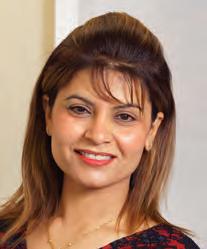
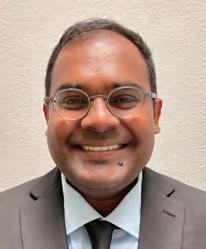
Sakineh Chabi, an assistant professor in the Department of Mechanical Engineering, has been selected for a 2024 Air Force Research Laboratory (AFRL) Summer Faculty Fellowship. Chabi’s proposal is titled “Research on Nano-Semiconductor Heterostructures.”
Madura Pathirage, an assistant professor in the Gerald May Department of Civil, Construction and Environmental Engineering, has received the 2024 Oak Ridge Associated Universities (ORAU) Ralph E. Powe Junior Faculty Enhancement Award. The grant funds will support Pathirage in his research to assess the primary containment and the concrete biological shield structures of nuclear power plants under extreme dynamic events through analytical and numerical modeling.
Donna Riley, Jim and Ellen King Dean of Engineering and Computing was honored this spring as New Mexico Technology Council as a Women in Tech Award recipient.
Abhaya Datye, a Distinguished Regents Professor in the Department of Chemical and Biological Engineering, received the 2024 award for Exceptional Achievements in Catalysis from the American Chemical Society (ACS). The award is given by the Catalysis Science and Technology Division of ACS. Datye’s award “acknowledges excellence and scientific leadership in catalysis science and technology by an individual, emphasizing the impact of a researcher’s body of work in the broad field of catalytic chemistry and catalytic materials or molecules.”
Gabriel López, Distinguished Professor of Chemical and Biological Engineering, is one of the recipients of the NSF Trailblazer Engineering Impact Award, an $18 million initiative that has the goal of helping researchers who have a strong history of creativity and finding novel solutions to pursue more novel projects that will open unexplored territory. His project is titled “Overcoming the Lignin Barrier for Valorization of Forest Biomass — A New Paradigm for Mitigation of Catastrophic Wildfires.” The $3 million, three-year project began Sept. 1.
Shuya Wei, an assistant professor in the Department of Chemical and Biological Engineering, is leading a project involving new technology for batteries that is part of the NASA Minority University Research and Education Project (MUREP) Partnership Learning Annual Notification (MPLAN) award. Wei’s project is titled “All-climate and Ultrafast Aluminum Ion Batteries.” UNM was one of 23 minority-serving institutions selected by NASA to receive $1.2 million. Selected institutions will receive up to $50,000 each for a six-month period to work directly on projects with subject matter experts in NASA’s mission directorates.
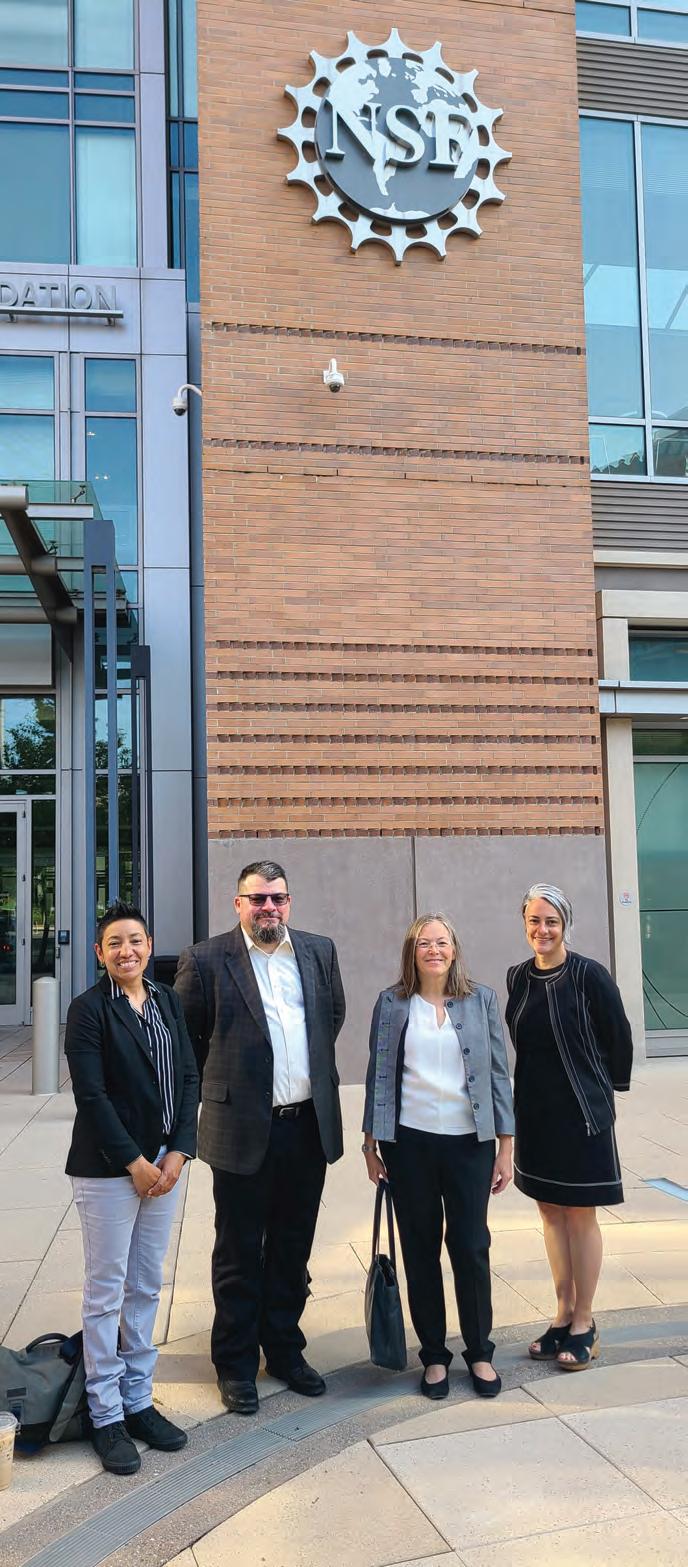

Donna Riley, Jim and Ellen King Dean of Engineering and Computing, is the principal investigator of “Planning a Center for Equity in Engineering at The University of New Mexico.” The $1.2 million project began Sept. 1, 2024, and is set to conclude Aug. 21, 2026. Co-principal investigators on the project are Melanie Moses, professor of computer science and special advisor to the dean on educational initiatives; Eva Chi, professor of chemical and biological engineering and associate dean for faculty affairs in Engineering; and Vanessa Svhila, associate professor of chemical and biological engineering and special assistant to the dean for learning sciences. The project aims to build infrastructure for equity through leadership accountability, resource management, data and metric development, partnership enhancement, and shifting reward structures and cultures in the School of Engineering.
Milad Marvian, an assistant professor in the Department of Electrical and Computer Engineering and a member of the Center for Quantum Information and Control (CQuIC), is leading one of 15 projects across the country receiving $11 million in funding from the Department of Energy. Marvian is receiving $500,000 for a project called “Bridging Between Quantum Circuit Model and Constrained Hamiltonianbased Computation.” These projects are focused on exploratory research for extreme-scale science that will leverage emerging trends and advances in high-end computing, massive datasets, scientific machine learning, artificial intelligence, and novel computing architectures.

Christopher Perfetti, an associate professor of nuclear engineering, is the principal investigator of two research projects focusing on nuclear reactor fuel cycles and nuclear criticality safety. The Nuclear Regulatory Commission is funding “Using Depletion Sensitivity Analysis to Better Characterize Reactor Fuel Cycles” for $500,000 over three years. He is also leading a project funded by Los Alamos National Laboratory’s Nuclear Criticality Safety Division called “Physics-based Nuclear Criticality Safety Validation of Heat-Source Plutonium.”
Osman Anderoglu, an associate professor of nuclear engineering, is leading a Department of Energy project that will study effects of external magnetic field on metallic coolants, which will create robust research and internship opportunities for both undergraduate and graduate students in the area of fusion energy. He is the principal investigator of “Liquid Metal-Materials Interactions in Extreme Environments,” which is funded by the Department of Energy Office of Science’s Reaching a New Energy Sciences Workforce (RENEW) initiative.
Nathan Jackson, an associate professor in the Department of Mechanical Engineering, is leading a project funded with an American Cancer Society Institutional Research Grant for a pilot study on developing a new way to detect ovarian cancer. The project, being conducted in conjunction with the UNM Comprehensive Cancer Center, will focus on developing a device — a probe to specifically target the biomarker for ovarian cancer. It will also involve developing the device’s acoustofluidic particle separation capability that can be utilized for multiple biomarkers for cancer cell detection. Jackson said this device would be a new and innovative concept in the early and accurate detection of ovarian cancer biomarkers.
Susan Bogus Halter, a longtime professor in the Gerald May Department of Civil, Construction and Environmental Engineering, has been selected as the chair of the department after a national search.

She has been serving as interim chair since 2023. She joined UNM in 2004 as an assistant professor after spending a decade in industry.
She has held the AGC (Associated General Contractors) Endowed Chair position since 2016. Bogus Halter also is the recipient of the 2020 Outstanding Educator Award from the National Association of Home Builders student chapter and was elected to the National Academy of Construction in 2021.
The southern Wisconsin native said that her interest in civil engineering began in high school, when she took an aptitude test that indicated she had the qualities to be an engineer.
“In my mind, I wanted to build roads and bridges,” she said.
She earned bachelor’s and master’s degrees in civil and environmental engineering from the University of Wisconsin-Madison, then worked as an environmental
engineer for CH2M Hill as a project manager and project engineer.
It was her love of school that led her back into academia, where she decided to return to school for her doctoral degree so she could be a professor. She earned a Ph.D. 2004 from University of Colorado, Boulder.
She joined UNM and has stayed here all of her academic career.
“I LOVE THE DEPARTMENT AND THE CULTURE. I LOVE THE MENTORING AND COLLABORATION WE HAVE,” SHE SAID. “THINGS ARE HAPPENING AND ALWAYS CHANGING.”
Her love for the department also is what helped her decide to want to lead the department.
“I see it as part of giving back to the department that has given me so much,” Bogus Halter said.
As chair, she plans to continue and grow the strong connection that the department has with industry, alumni and donors. The relationship with one alum and donor, Doug Campbell, led to the endowment of the department as the Gerald May Department of Civil, Construction and Environmental Engineering, which provides Bogus Halter with extra resources to support and grow the department.
She is looking forward to working on a variety of projects, including recruitment of students and faculty, faculty mentoring, alignment with the School’s strategic plan as well as UNM 2040, growing the breadth of research, and continuing to raise funds.
Being in charge of a department is inherently challenging, but Bogus Halter is optimistic that by taking care of students, faculty and staff, the right things will happen.
“I don’t plan on doing anything different, and by doing that, we will continue to grow,” she said.
In her free time, she enjoys Lobo sports, Popejoy events, as well as traveling and spending time outdoors hiking, biking and skiing.
In the 1980s and 1990s, millions of youngsters dreamed they could “be like Mike” — legendary Chicago Bulls basketball player Michael Jordan.
Growing up in China, Shuang (Sean) Luan was one of those who idolized Jordan. In fact, his love of Michael Jordan is what persuaded him to attend graduate school in the United States.
Luan started Aug. 1 as the associate dean for academic affairs and community engagement in the School of Engineering. But before he set his sights on academia, his dreams were on the court.
“I wanted to be a basketball player, and I was hoping that I would grow to be 6'4" or 6'5" but I only made it to 6 feet,” he said.
Even though he realized his hoop dreams may not materialize, he was still dazzled by Jordan and the Chicago Bulls. So after earning a bachelor’s degree in computer science and engineering from the Harbin Institute of Technology in China in 1998, he pursued graduate school in the U.S., targeting the Chicago area to be close to his favorite player and team.
“I applied to University of Chicago and Notre Dame,” he said. “Notre Dame was the only one who gave me a lot of attention, so I chose them.”
He earned his master’s and Ph.D. in computer science from Notre Dame in 2002 and 2004, respectively. He has been a professor in the UNM Department of Computer Science since 2004, recruited by Professor Deepak Kapur.
His research and teaching focus has been in the area of biomedical engineering challenges, utilizing computational geometry.
Luan loves the climate and culture of New Mexico, but also fell in love with the unique community that is UNM. Having attended graduate school at a prestigious private institution like Notre Dame, he saw some extreme differences between universities like that and UNM.

“So many of our students are first generation, many have families, some even have two jobs while going to school,” he said. “So when I see them succeed, it’s so much more satisfying.”
During his 20 years as a computer science professor, he could readily cite several examples of the transformative impact that UNM has had on students. “They are doing amazing work,” he said. “I think our students benefit from talking not just about academics, but about life. I feel that a lot of students don’t realize their potential. I love to help them see this.”
That is what attracted him to the job of associate dean — the ability to help students understand how to achieve their dreams. “It’s not how you start in life, it’s how you end up,” Luan said.
In terms of goals for the position, Luan said he would like to find more opportunities to work with the Engineering Student Success Center, the academic advisors, and the Center for Teaching and Learning to ease students’ transition into engineering. He is especially interested in improving students’ readiness, providing them time to acquire the needed skills such as calculus that prepares them for an engineering or computer science degree. He also would like to expand students’ programming skills, especially in AI. Longer term, he is also interested in starting an undergraduate degree program in bioinformatics, which he feels has great potential to reach a broader set of students, including females and groups that are underrepresented in engineering and computer science.
Luan and his wife, a UNM Health Sciences Center pharmacist, have a 12-year-old son and a 7-year-old daughter. In his spare time, he still enjoys basketball and likes to play chess.
Hoop dreams: Alumnus’ gift provides scholarships to engineering students in need
Fred Armijo knows what it is like to struggle. Armijo earned a bachelor’s degree in chemical engineering from UNM in 1969, then had a long and successful career in the oil and gas industry. Today, Fred and his wife of four decades, Dorothy, live a comfortable life free of financial worries at their home in Dallas, but possessing the peace of mind that comes with having all your needs met and more was not something that Armijo was familiar with until early adulthood.
But now he is in a position to give back, and the Armijos are doing so in a big way. He and his wife recently established a scholarship to help students like him. “We wanted to create this scholarship so students wouldn’t have to struggle the way I did in school,” he said. “We want students to succeed.”
The Fred and Dorothy Armijo Scholarship Fund will create scholarships for UNM students, with preference given to chemical and other engineering majors. The primary criteria that was important to the Armijos was to fully meet each recipient’s unmet financial need, which is the amount left to pay of a student’s total college costs after family contribution and need-based aid are considered. They also want to make sure the chemical engineering department and the School of Engineering reflect the diversity that is a deep part of New Mexico.
Armijo was the first in his family to go to college. His first year in the chemical engineering program at UNM, he was an honor student, then his grades started slipping because he was working as many as three jobs at a time to make ends meet.
However, he was still able to work in some leisure. Armijo was skilled at running track (the 440-yard dash) as well as playing basketball, and it was a basketball hoop near the engineering buildings that held special meaning for him. And that hoop — now attached to the Nuclear Engineering Building — has been named in his honor as the Fred and Dorothy Armijo Hoop — approved by the UNM Board of Regents earlier this year.

little play, the hoop was a life saver. “The hoop was our R&R.”
Fred insisted that the Armijo scholarship not require a lofty grade-point average. He knows first hand how grades can slip when students are pulled away from their studies trying to earn money to stay in school. He graduated with a 2.4 GPA.
He met Dorothy Ashworth at work (they worked for the same company in Texas), and they married in 1985. Fred says he and Dorothy have a true partnership and say that even though he is the alumnus of UNM, this gift was very deliberate and from both of them.
The Armijos say they have been lucky in their life — making some financial decisions that were risky at the time but paid off more than they expected — and now is the time to help others. Of all the places they can invest their money, Fred and Dorothy agree that providing solid and consistent support to the School of Engineering and the Department of Chemical and Biological Engineering is the most meaningful to them.

Between classes, Armijo said he would let off steam by shooting a few baskets, and in his life of hard work and
“CHEM E STUDENTS ARE WHERE OUR HEARTS ARE, AND WE WANT THE DEPARTMENT TO KEEP ON DOING WHAT THEY’VE BEEN DOING AND TURNING OUT GREAT STUDENTS,” FRED SAID.
To learn more about the Fred and Dorothy Armijo Scholarship, contact Elsa Maria Castillo at the Engineering Student Success Center at elsac@unm.edu or scholarships@unm.edu.

Lisa Losada-Rojas joined the Gerald May Department of Civil, Construction and Environmental Engineering in fall 2022, specializing in transportation. Almost two years in, she says that “my students gave me the purpose of doing this job, especially my graduate ones whom I mentor closely.” When she is not working, she enjoys dancing, cooking and commuting on her bike.
Explain your research and your involvement with the Center for Pedestrian and Bicyclist Safety
I aim to develop and advance transportation solutions that positively impact community health. Transportation is a topic that concerns us all to a certain extent. However, linking it with the word ‘health’ opens many interconnections that I hope to tackle in my research. From understanding sustainable transit provision in rural settings, access to healthy opportunities, and ways to make infrastructure safer for non-motorized modes.
What made you choose civil engineering as a field?
Initially, I did not want to become a civil engineer. I was more excited about being in social sciences. When I applied to undergraduate, I made it to my country’s top school for civil engineering on the first try, and it was hard to say no. However, I regretted this decision in my junior year. So, I took a semester gap to think things through. I traveled to Europe and learned English, which was a life-changing experience. It was my first time seeing well-designed transportation systems, exciting bicyclist and pedestrian infrastructure, and top-notch urbanism I had never experienced before. I remember I called my dad one day and told him, ‘Dad, I know what I want to do? I want to design transportation systems.’ He replied, ‘Do you know who does that?’ And I said, ‘Not really.’ Then he says, ‘Civil engineers. Come back and finish that degree.’ So I did.
What do you see as some of the emerging trends in transportation?
Transportation is at a tipping point regarding various technology adoptions (including AVs, electric vehicles, mobility as a service, micromobility and autonomous deliveries), increased online shopping and telework. Additionally, we are more connected than ever, and I foresee a lot of changes in how we decide to move given those strengthened connections.
What are some of your current projects?
One of my ongoing projects aims to develop strategies to reshape travel behavior patterns in disadvantaged and frequently underserved areas by adopting innovative transportation solutions and creating sustainable transit services in rural New Mexico. Another funded project in progress with the Center for Pedestrian and Bicyclist Safety explores how external factors and mental workload may affect cyclist safety to develop precise planning guidelines for future non-motorized infrastructure considering human factors.
What impact do you hope to have with your teaching and research in transportation?
My aspiration is to cultivate healthier communities and foster sustainable transportation systems through strategic planning. I am interested in developing courses that explore the connection between transportation planning choices and their far-reaching effects on public health, specifically emphasizing the impact of transportation innovations.
